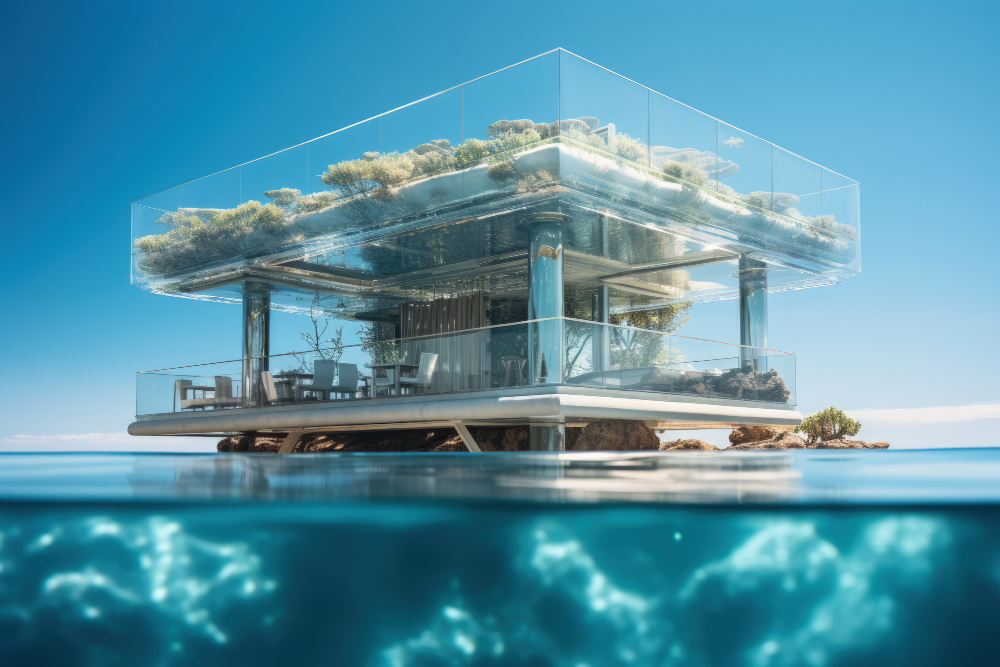Underwater House Ideas : Innovative Concepts for Living Beneath the Waves – Underwater housing represents a bold and fascinating vision for the future of architecture and urban planning. While building and living underwater might seem like something out of a science fiction movie, advances in technology and architecture have made the concept increasingly plausible.
Underwater homes offer a unique lifestyle, with unparalleled views of marine life and a tranquil, serene environment. Here are some innovative ideas and concepts for creating underwater houses :
1. Submerged Bubble Homes
Submerged bubble homes are one concept that combines the functionality of traditional homes with the aesthetics of underwater living. These homes could feature transparent walls made from strong, clear materials such as acrylic or specialized glass, allowing residents to view their surroundings while remaining protected from the water.
- 360-degree views : Transparent walls provide an immersive view of the underwater environment.
- Pressure-resistant materials : Advanced materials and construction techniques ensure the home withstands water pressure at various depths.
- Efficient energy systems : Renewable energy sources like solar panels on floating platforms or water-based energy harvesting systems can provide power.
Read Next Article : Financial Management Nigeria : Empowering Individuals and Businesses
2. Floating Platforms and Tethers
Underwater houses can be designed with floating platforms on the surface that support the structure below. These platforms could contain essential amenities such as power generation systems, water treatment facilities, and emergency escape routes.
- Easy access to the surface : Floating platforms provide direct access to the surface for transportation and emergencies.
- Stabilization and anchoring : Tethered to the sea floor, these houses maintain stability and resist shifting due to currents.
- Hybrid living : Residents can enjoy both underwater and surface-level living, offering more versatility.
3. Underwater Eco-Lodges
Eco-lodges built underwater could promote sustainable tourism while offering a unique experience for visitors. These lodges would emphasize eco-friendly construction, responsible resource management, and harmony with the marine environment.
- Sustainable materials : Construction with eco-friendly materials minimizes the impact on the marine ecosystem.
- Marine conservation : Eco-lodges could partner with marine conservation organizations to protect and preserve the local underwater habitat.
- Educational experiences : Visitors can learn about marine life and the importance of ocean conservation through guided tours and interactive exhibits.
4. Multi-Story Subaquatic Residences
Multi-story underwater residences offer the potential for expansive living spaces with multiple levels, much like traditional houses but beneath the sea.
- Zoning and layouts : Different floors can serve specific purposes, such as living spaces, bedrooms, and recreational areas.
- Pressure chambers and airlocks : Special chambers ensure a safe transition between underwater and surface environments.
- Innovative designs : Architects can experiment with bold designs and artistic concepts to create visually striking underwater homes.
5. Underwater Research and Education Centers
Combining housing with research and educational facilities, these centers could provide accommodations for scientists and students studying marine biology, oceanography, and related fields.
- Laboratories and classrooms : Facilities for research and education can be integrated into the design.
- Collaborative spaces : Shared living and working spaces can foster collaboration and knowledge exchange.
- Observation decks : Designated areas for observing marine life and conducting research.
Conclusion
While underwater housing remains a niche concept, it holds immense potential for the future of architecture, tourism, and scientific research. As technology advances, underwater homes may become more feasible and sustainable, offering a unique way to connect with the ocean and its ecosystems.
Such innovation can open up exciting possibilities for how humans might live, work, and thrive in harmony with the underwater world.

